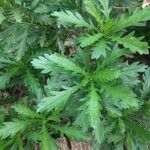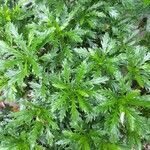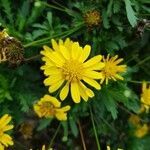A bushily branching erect shrub 0.5-2 m tall, glabrous except for some tomentum at peduncle-bases and in leaf-axils. Young branches closely leafy, soon becoming denuded. Leaves closely set, spreading, flat, herbaceous, shallowly-deeply pinnatilobate, 3-10 cm long, 1-3 cm wide, broadest above the middle, basally narrowed into a petiole-like portion, pinnately veined with a distinct midvein and thinner lateral veins; veins fine and impressed on the adaxial side, raised and prominent on the reverse; leaf-lobes 3-10 on each side, ovate-lanceolate, 2-20 mm long, up to 5 mm wide, subacute-obtuse and mucronate, the basal ones gradually smaller, acuminate-subulate. Peduncles terminal, often several together, erect, 5-20 cm long, 0.6-1 mm thick or slightly more, somewhat thickened below the capitula, striate-sulcate, with tufts of white wool surrounding the base. Involucre widely campanulate, 1-1.8 cm in diam. Involucral bracts subbiseriate, partly overlapping, 8-15, ovate-lanceolate, 5-8 mm long, 2-4 mm wide, green, faintly striate, basally connate (to 1/5-1/3), with obtuse-subacute puberulous tips. Receptacle convex-conical, alveolate. Ray-florets 11-20, yellow. Tube cylindrical, 1-2 mm long. Lamina narrowly obovate-oblanceolate(-linear), (8-)12-20 mm long, (2-)2.5-5 mm wide, 4(-7)-veined, usually widest above the middle. Style terete; style branches flattened, c. 1 mm long. Disc-florets c. 50-125. Corolla 4-5 mm long. Tube cylindrical, 1-1.5 mm long. Limb very narrowly campanulate, 3-3.5 mm long; lobes narrowly ovate, c. 1 mm long. Anthers (1.7-)2 mm long incl. the narrowly ovate acute appendage. Style terete; style branches c. 0.8(-1) mm long, with conical tips. Pappus 0. Achenes (narrowly) oblong-obovate to almost fusiform, 3.5-5 mm long, 1-2 mm wide, brown-black, glabrous, with 8-11 longitudinal ribs.
More
Shrubs to c. 1.5 m high, largely glabrous. Leaves crowded, slightly fleshy, narrowly elliptic to obovate, to 8 cm long, pinnatisect reducing to lobate distally; segments ±narrowly oblong, entire. Capitula 1 per branch but often a few branches clustered; peduncle to c. 20 cm long; involucre broadly campanulate, 5–8 mm long; bracts 8–15, connate in proximal 1/5–1/4; stereome flat, with inconspicuous resin ducts; margin of receptacular pits raised. Ligulate florets 8–15; ligule to c. 20 mm long, commonly 4-veined. Disc florets numerous; corolla c. 4.5 mm long, c. 0.5 mm diam. at base; limb c. 2/3 of total length. Achenes obovoid, 3–5 mm long, 10-ribbed, glabrous, without stylopodium. Pappus absent.
Branched, erect shrub, 0.5-2.0 m high, glabrous; young stems leafy, soon denuded. Leaves spreading, broadest above middle, pinnately veined, base petiolate, lobes 6-20, ovate to lanceolate, 2-20 mm long. Peduncles terminal, often several together, erect, 50-200 mm long. Capitula up to 35 mm in diam.; involucre widely campanulate, 10-18 mm in diam.; bracts 8-15, ovate to lanceolate, 5-8 mm long, connate to 1/5-1/3. Receptacle ± convex, alveolate. Ray florets 11-20, yellow. Disc florets 50-125. Flowering time all year. Cypselae ± oblong-obovate, 3.5-5.0 mm long, glabrous, longitudinal ribs 8-11.
Shrub 0.5–2 m high, nearly completely glabrous.. Leaves pinnatilobate, 3–10 cm long, 1–3 cm wide.. Capitula solitary on stalks 5–20 cm long.. Ray and disc florets yellow, glabrous.. Achenes black, pappus absent.



